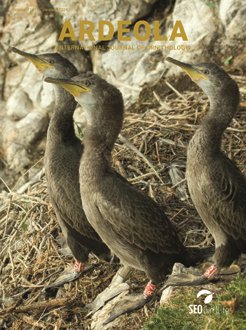Seabirds spend most of the year offshore, out of human sight, covering great distances while migrating and foraging for food often in remote areas of the high seas. Several small seabirds that anthropogenic activities might threaten have hitherto remained untracked. One such species is the anti-tropical White-faced Storm-petrel Pelagodroma marina. Indeed, its movements and activity patterns are largely unknown, although often regarded as dispersive. In this study, we aimed to identify the post-breeding movements and the daily activity patterns of White-faced Storm-petrels breeding in Cabo Verde (P. m. eadesorum). We tracked five adults with geolocators (GLS) between 2019 and 2022 and modelled their routes using Satellite Geolocation for Animal Tracking (SGAT). We programmed geolocators to record when the bird was dry or on the water to understand their daily activity patterns during the non-breeding period. Results showed that the White-faced Storm-petrels breeding in Cabo Verde are truly migratory, heading towards the northwest Atlantic in May-June and returning in October-November through the northeast towards Cabo Verde, following a clockwise movement. Birds spent the non-breeding period in areas associated with seamounts along the mid-Atlantic Ridge and south of the Azores. In addition, we found that the species is mainly active at night during the non-breeding season, suggesting that it takes advantage of the diel vertical migration of zooplankton and nekton associated with seamounts. The time spent on the water increased before returning to the colony, probably due to reduced flying ability during the moulting period. Our data add to the growing evidence that the North-central Atlantic is a crucial location for the conservation of pelagic seabirds and highlights the need to protect these remote areas from the increasing human impact on the high seas.—Medrano, F., Repullés, K., Militão, T., Leal, A. & González-Solís, J. (2024). Migratory movements and activity patterns of White-faced Storm-petrels Pelagodroma marina breeding in Cabo Verde. Ardeola, 71: 101-118.
Las aves marinas pelágicas pasan la mayor parte del año en alta mar, recorriendo grandes distancias y a menudo en áreas remotas poco protegidas de alta mar. Considerando que varias especies de aves marinas pueden estar siendo afectadas por actividades antrópicas durante su migración, es relevante conocer las zonas visitadas durante esta etapa. Una especie cuya migración es poco conocida es el paíño pechialbo Pelagodroma marina. Hasta ahora, no se había investigado si realizan una migración o solo existe dispersión. Además, la especie es nocturna durante la incubación y diurna/nocturna durante la cría del pollo, pero no se conocen sus patrones de actividad durante la migración. En este estudio, caracterizamos los movimientos migratorios del paíño pechialbo en Cabo Verde (P. m. eadesorum), rastreando seis adultos con geolocalizadores (GLS) entre 2019 y 2022, y modelamos sus rutas migratorias. Para comprender su actividad diaria fuera, registramos el tiempo que pasan en el agua mediante geolocalizadores. Los resultados mostraron que la especie migra en mayo-junio dirigiéndose hacia el noroeste del Atlántico, y regresan en octubre-noviembre por el noreste hacia Cabo Verde, en el sentido de las agujas del reloj. Las principales áreas no reproductivas están ubicadas a lo largo de la Dorsal Atlántica y al sur de Azores, un área con numerosos montes submarinos. Los datos de actividad mostraron que la especie es principalmente nocturna y que el tiempo que pasan en el agua tiende a aumentar antes de regresar a la colonia, probablemente debido a una capacidad de vuelo disminuida durante el proceso de muda. Nuestros datos se suman a la evidencia que muestra que el Atlántico norte central es un sitio clave para la conservación de las aves marinas pelágicas y resalta la necesidad de proteger estas áreas remotas para mitigar los crecientes impactos de las actividades humanas en alta mar.—Medrano, F., Repullés, K., Militão, T., Leal, A. y González-Solís, J. (2024). Movimientos migratorios y patrones de actividad de los paíños pechialbos Pelagodroma marina que anidan en Cabo Verde. Ardeola, 71: 101-118.






